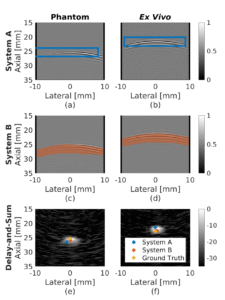 Congratulations to Mardava Gubbi! His first-author paper entitled “Deep learning to localize photoacoustic sources in three dimensions: Theory and implementation” was accepted for publication in IEEE Transactions on Ultrasonics, Ferroelectrics, and Frequency Control.
Congratulations to Mardava Gubbi! His first-author paper entitled “Deep learning to localize photoacoustic sources in three dimensions: Theory and implementation” was accepted for publication in IEEE Transactions on Ultrasonics, Ferroelectrics, and Frequency Control.
This paper introduces two novel deep learning-based three-dimensional (3D) photoacoustic point source localization systems. One system uses an object detection-based approach with elevation-encoded classification (System A). The second system uses our novel theoretical framework relating the three-dimensional location of photoacoustic point sources, sound speeds, and waveform shapes in photoacoustic raw channel data (System B). System B leverages our theoretical framework to implement a novel instance segmentation and least squares optimization-based photoacoustic point source location and sound speed estimation approach. This instance segmentation-based system improves localization and sound speed estimation performance in simulated, phantom, and ex vivo data compared to traditional methods. Overall, the results enhance the potential applicability of photoacoustic guidance to surgical and interventional scenarios.
Citation: M. R. Gubbi and M. A. Lediju Bell, Deep Learning to Localize Photoacoustic Sources in Three Dimensions: Theory and Implementation, IEEE Transactions on Ultrasonics, Ferroelectrics, and Frequency Control (accepted April 15, 2025) [pdf]
